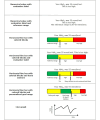Enhancing Patient Understanding of Laboratory Test Results: Systematic Review of Presentation Formats and Their Impact on Perception, Decision, Action, and Memory
- PMID: 39133906
- PMCID: PMC11347896
- DOI: 10.2196/53993
Enhancing Patient Understanding of Laboratory Test Results: Systematic Review of Presentation Formats and Their Impact on Perception, Decision, Action, and Memory
Abstract
Background: Direct access of patients to their web-based patient portal, including laboratory test results, has become increasingly common. Numeric laboratory results can be challenging to interpret for patients, which may lead to anxiety, confusion, and unnecessary doctor consultations. Laboratory results can be presented in different formats, but there is limited evidence regarding how these presentation formats impact patients' processing of the information.
Objective: This study aims to synthesize the evidence on effective formats for presenting numeric laboratory test results with a focus on outcomes related to patients' information processing, including affective perception, perceived magnitude, cognitive perception, perception of communication, decision, action, and memory.
Methods: The search was conducted in 3 databases (PubMed, Web of Science, and Embase) from inception until May 31, 2023. We included quantitative, qualitative, and mixed methods articles describing or comparing formats for presenting diagnostic laboratory test results to patients. Two reviewers independently extracted and synthesized the characteristics of the articles and presentation formats used. The quality of the included articles was assessed by 2 independent reviewers using the Mixed Methods Appraisal Tool.
Results: A total of 18 studies were included, which were heterogeneous in terms of study design and primary outcomes used. The quality of the articles ranged from poor to excellent. Most studies (n=16, 89%) used mock test results. The most frequently used presentation formats were numerical values with reference ranges (n=12), horizontal line bars with colored blocks (n=12), or a combination of horizontal line bars with numerical values (n=8). All studies examined perception as an outcome, while action and memory were studied in 1 and 3 articles, respectively. In general, participants' satisfaction and usability were the highest when test results were presented using horizontal line bars with colored blocks. Adding reference ranges or personalized information (eg, goal ranges) further increased participants' perception. Additionally, horizontal line bars significantly decreased participants' tendency to search for information or to contact their physician, compared with numerical values with reference ranges.
Conclusions: In this review, we synthesized available evidence on effective presentation formats for laboratory test results. The use of horizontal line bars with reference ranges or personalized goal ranges increased participants' cognitive perception and perception of communication while decreasing participants' tendency to contact their physicians. Action and memory were less frequently studied, so no conclusion could be drawn about a single preferred format regarding these outcomes. Therefore, the use of horizontal line bars with reference ranges or personalized goal ranges is recommended to enhance patients' information processing of laboratory test results. Further research should focus on real-life settings and diverse presentation formats in combination with outcomes related to patients' information processing.
Keywords: clinical laboratory information systems; electronic health record; health communication; health informatics; laboratory test results; patient access to records; patient engagement; patient involvement; patient portal.
©Frederieke A M van der Mee, Fleur Schaper, Jesse Jansen, Judith A P Bons, Steven J R Meex, Jochen W L Cals. Originally published in the Journal of Medical Internet Research (https://www.jmir.org), 12.08.2024.
Conflict of interest statement
Conflicts of Interest: None declared.
Figures
Similar articles
-
Prescription of Controlled Substances: Benefits and Risks.2025 Jul 6. In: StatPearls [Internet]. Treasure Island (FL): StatPearls Publishing; 2025 Jan–. 2025 Jul 6. In: StatPearls [Internet]. Treasure Island (FL): StatPearls Publishing; 2025 Jan–. PMID: 30726003 Free Books & Documents.
-
Interventions to improve safe and effective medicines use by consumers: an overview of systematic reviews.Cochrane Database Syst Rev. 2014 Apr 29;2014(4):CD007768. doi: 10.1002/14651858.CD007768.pub3. Cochrane Database Syst Rev. 2014. PMID: 24777444 Free PMC article.
-
Interventions for interpersonal communication about end of life care between health practitioners and affected people.Cochrane Database Syst Rev. 2022 Jul 8;7(7):CD013116. doi: 10.1002/14651858.CD013116.pub2. Cochrane Database Syst Rev. 2022. PMID: 35802350 Free PMC article.
-
Falls prevention interventions for community-dwelling older adults: systematic review and meta-analysis of benefits, harms, and patient values and preferences.Syst Rev. 2024 Nov 26;13(1):289. doi: 10.1186/s13643-024-02681-3. Syst Rev. 2024. PMID: 39593159 Free PMC article.
-
Signs and symptoms to determine if a patient presenting in primary care or hospital outpatient settings has COVID-19.Cochrane Database Syst Rev. 2022 May 20;5(5):CD013665. doi: 10.1002/14651858.CD013665.pub3. Cochrane Database Syst Rev. 2022. PMID: 35593186 Free PMC article.
Cited by
-
Perceptions, Experiences, and Beliefs About Patient Portals Among Women With Limited English Proficiency: Multicultural Qualitative Interview Study.J Med Internet Res. 2025 Feb 26;27:e60699. doi: 10.2196/60699. J Med Internet Res. 2025. PMID: 40009438 Free PMC article.
-
Molecular monitoring in CML-a modern example of an old proverb.Blood Cancer J. 2024 Nov 28;14(1):211. doi: 10.1038/s41408-024-01192-7. Blood Cancer J. 2024. PMID: 39609389 Free PMC article. No abstract available.
-
The impact of different radiology report formats on patient information processing: a systematic review.Eur Radiol. 2025 May;35(5):2644-2657. doi: 10.1007/s00330-024-11165-w. Epub 2024 Nov 15. Eur Radiol. 2025. PMID: 39545980 Free PMC article.
References
-
- Kaelber DC, Jha AK, Johnston D, Middleton B, Bates DW. A research agenda for personal health records (PHRs) J Am Med Inform Assoc. 2008;15(6):729–736. doi: 10.1197/jamia.M2547. https://europepmc.org/abstract/MED/18756002 M2547 - DOI - PMC - PubMed
-
- Tang PC, Ash JS, Bates DW, Overhage JM, Sands DZ. Personal health records: definitions, benefits, and strategies for overcoming barriers to adoption. J Am Med Inform Assoc. 2006;13(2):121–126. doi: 10.1197/jamia.M2025. https://europepmc.org/abstract/MED/16357345 M2025 - DOI - PMC - PubMed
-
- Fisher B, Bhavnani V, Winfield M. How patients use access to their full health records: a qualitative study of patients in general practice. J R Soc Med. 2009;102(12):539–544. doi: 10.1258/jrsm.2009.090328. https://europepmc.org/abstract/MED/19966130 102/12/539 - DOI - PMC - PubMed
Publication types
MeSH terms
LinkOut - more resources
Full Text Sources
Medical



